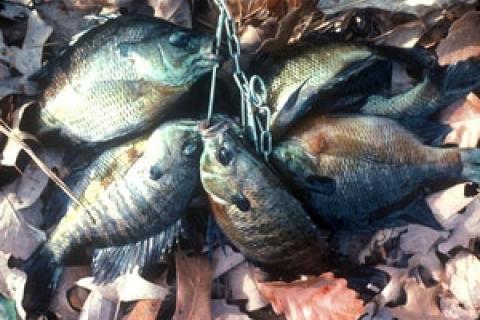
No fish are more appealing to go after on a hot summer day than panfish. Unlike bass, trout and stripers, which can sometimes be difficult to catch, species like crappies, bluegills and white bass are almost always willing to nab a lure, bait or fly. They're made to order for those days when you want to take it easy, kick back and enjoy being out on a lake or river without too much concentration on finesse tactics-yet still come home with a cooler full of fish!
Simply put: panfish are reliable. And because of that, they're great quarries for taking youngsters or newcomers to angling along to enjoy the sport.
Here are 10 proven tips to help you score on a variety of panfish this summer.
 #1. White and chartreuse jigs are top offerings for white bass in 1/8-1/4 ounce sizes. Try a variety of retrieves, starting with slow steady reeling. If that doesn't produce, pause part way back and let the lure drop for a few seconds like a wounded minnow. For a third approach, try reeling a few feet, then twitching, reeling, then twitching.
#1. White and chartreuse jigs are top offerings for white bass in 1/8-1/4 ounce sizes. Try a variety of retrieves, starting with slow steady reeling. If that doesn't produce, pause part way back and let the lure drop for a few seconds like a wounded minnow. For a third approach, try reeling a few feet, then twitching, reeling, then twitching.
#2. One of the top spots to find crappies in summer is around bridge pilings. These concrete spans offer shade and structure for the fish to hang out next to and ambush baitfish that fin past. Work the pilings closest to land first. Then probe those where the creek or river channel drops off into deeper water if they don't produce. Use marabou or plastic tailed jigs or small live shiners suspended beneath a bobber.
#3. If you missed the spring bluegill spawn, don't fret. These fish often return to the shallows to breed a second and even third time through July. Look for the beds in 1 to 4 feet of water during full moon periods.
#4. When white bass are hard to locate, try trolling. This lets you present the fish with several lure choices at one time and probe a variety of depths. Top offerings include silver spoons, small crankbaits, diving thin-minnow plugs, lipless crankbaits and jig-spinner combos. Motor slowly through areas where humps rise up off the lake floor and over points, drop-offs and creek mouths in depths of 8-24 feet.
#5. Sponge rubber spiders are one of the top fly rod offerings for bluegills. But often the legs are tied too long. This makes them tangle on the hook and encourages fish to grab the tails without getting the hook in their mouths. If legs are more than 1/3-inch long, trim them back to that length with scissors. They won't tangle and you'll draw solid hookups.
 #6. One of the top baits for yellow perch is a small live minnow. If you don't have any or run out of bait, try this trick. Cut a thin tapered strip of white belly meat from one of the fish you've already caught. It should be 1/4- to 1/2-inch wide at the end and taper for 1-2 inches to a thin tip. This offering also works on crappies, bluegills, rock bass and pickerel.
#6. One of the top baits for yellow perch is a small live minnow. If you don't have any or run out of bait, try this trick. Cut a thin tapered strip of white belly meat from one of the fish you've already caught. It should be 1/4- to 1/2-inch wide at the end and taper for 1-2 inches to a thin tip. This offering also works on crappies, bluegills, rock bass and pickerel.
#7. If action is slow, try slapping the water with your paddle. May sound crazy, but the commotion imitates feeding fish and at times will attract nearby crappies, bluegills and white bass to your offerings.
#8. A top lure for bluegills is a grub with a short stubby plastic body. Fish it slowly-just fast enough to keep it off the bottom. Part way back, pause briefly to draw strikes from trailing fish. Use 1/32- to 1/8-ounce versions in brown, green, black, smoke and purple.
#9. Try chumming if fishing is slow. Keep egg shells from your breakfast, crumple them up and sprinkle overboard. The slowly descending fragments will flutter through the water and draw in both baitfish and panfish.
#10. When fishing lakes, try these spots for panfish: inlets, outlets, points, coves, weed beds, areas with fallen trees or brush, underwater humps, springs, rock piles, flats and drop-offs.
When these tips pay off for you, be sure to keep a few specimens for a fish fry. Most of these species breed prolifically and thrive when they their numbers are kept in check. Deep fry them dipped in batter or saute in lemon and butter. After all, there's a reason they're called "pan" fish: they're delicious!
- 19926 views

